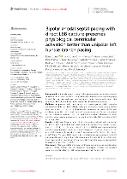Bipolar anodal septal pacing with direct LBB capture preserves physiological ventricular activation better than unipolar left bundle branch pacing

Autor
Jurák, Pavel
Prinzen, Frits
Jastrzębski, Marek
Halámek, Josef
Tothová, Markéta
Znojilová, Lucie
Smíšek, Radovan
Karch, Jakub
Povišer, Lukáš
Plešinger, Filip
Moskal, Pawel
Viščor, Ivo
Vondra, Vlastimil
Leinveber, Pavel
Datum vydání
2023Publikováno v
Frontiers in Cardiovascular MedicineRočník / Číslo vydání
10 (March)ISBN / ISSN
ISSN: 2297-055XInformace o financování
MSM//LX22NPO5104
UK/COOP/COOP
Metadata
Zobrazit celý záznamKolekce
Tato publikace má vydavatelskou verzi s DOI 10.3389/fcvm.2023.1140988
Abstrakt
BACKGROUND: Left bundle branch pacing (LBBP) produces delayed, unphysiological activation of the right ventricle. Using ultra-high-frequency electrocardiography (UHF-ECG), we explored how bipolar anodal septal pacing with direct LBB capture (aLBBP) affects the resultant ventricular depolarization pattern. METHODS: In patients with bradycardia, His bundle pacing (HBP), unipolar nonselective LBBP (nsLBBP), aLBBP, and right ventricular septal pacing (RVSP) were performed. Timing of local ventricular activation, in leads V1-V8, was displayed using UHF-ECG, and electrical dyssynchrony (e-DYS) was calculated as the difference between the first and last activation. Durations of local depolarizations were determined as the width of the UHF-QRS complex at 50% of its amplitude. RESULTS: aLBBP was feasible in 63 of 75 consecutive patients with successful nsLBBP. aLBBP significantly improved ventricular dyssynchrony (mean -9 ms; 95% CI (-12;-6) vs. -24 ms (-27;-21), ), p < 0.001) and shortened local depolarization durations in V1-V4 (mean differences -7 ms to -5 ms (-11;-1), p < 0.05) compared to nsLBBP. aLBBP resulted in e-DYS -9 ms (-12; -6) vs. e-DYS 10 ms (7;14), p < 0.001 during HBP. Local depolarization durations in V1-V2 during aLBBP were longer than HBP (differences 5-9 ms (1;14), p < 0.05, with local depolarization duration in V1 during aLBBP being the same as during RVSP (difference 2 ms (-2;6), p = 0.52). CONCLUSION: Although aLBBP improved ventricular synchrony and depolarization duration of the septum and RV compared to unipolar nsLBBP, the resultant ventricular depolarization was still less physiological than during HBP.
Klíčová slova
His bundle pacing, LBBP, anodal septal pacing, dyssynchrony, ultra-high-frequency ECG
Trvalý odkaz
https://hdl.handle.net/20.500.14178/2144Licence
Licence pro užití plného textu výsledku: Creative Commons Uveďte původ 4.0 International







